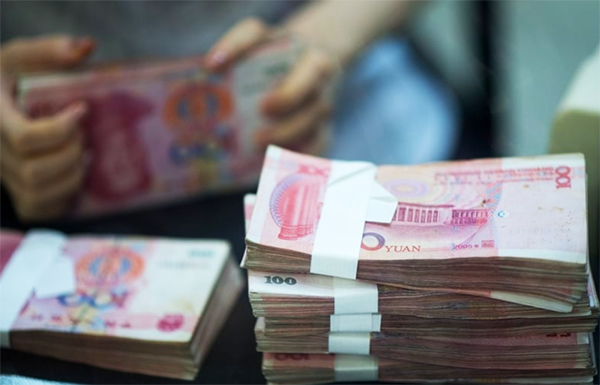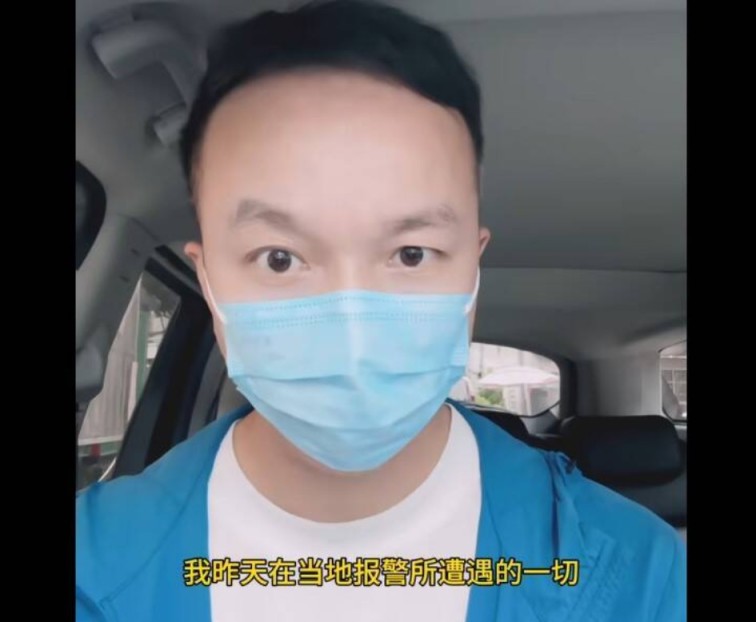Photo Caption: As the CCP's local government finances grow increasingly strained, governments across China are finding new ways to extract money from the public. (Getty Images)
[People News] Data from the Ministry of Finance indicates that by the end of September 2025, the total local government debt across the country has surged to 53.6995 trillion yuan, marking a 20% increase compared to the same period last year. The International Monetary Fund (IMF) has analysed that if implicit debts are taken into account, China's overall government debt could reach as high as 96.3% of GDP.
Over the decades of reform and opening up by the Chinese Communist Party (CCP), local governments have been borrowing excessively to inflate GDP figures, with officials pursuing political achievements through reckless infrastructure investments. As asset bubbles have formed, debts have accumulated like a snowball. This situation has revealed a serious imbalance in fiscal revenues and expenditures, and it also involves a power struggle between central and local finances. The local government debt of the CCP has become a significant burden that is difficult to reverse, and in the current economic downturn, it poses a potential threat to the entire economic system.
In an effort to maintain political stability, the central government has introduced a series of debt support measures. However, due to the bleak economic fundamentals, the impact has been minimal. In the first ten months of 2025, local bond issuance reached approximately 9.1 trillion yuan, a year-on-year increase of 23%. This includes about 4.7 trillion yuan in new local government bonds, which is a year-on-year increase of about 2%, and 4.4 trillion yuan in refinancing bonds, reflecting a year-on-year increase of about 58%. Refinancing bonds are primarily used for 'borrowing new to pay off old' debts and for replacing local governments' existing implicit debts.
The explosive growth of local debts has caused the Party to become anxious. Just how much more money needs to be funnelled into this bottomless pit?!
The mutual distrust between central and local governments has prompted the Ministry of Finance to establish a Debt Management Division.
On November 3, 2025, the Chinese Communist Party officially announced the establishment of the Debt Management Department within the Ministry of Finance. This new department comprises six divisions: the Comprehensive Division, the Central Debt Division, Local Debt Division I, Local Debt Division II, the Issuance and Redemption Division, and the Monitoring and Management Division. It consolidates all powers related to debt management—from formulating policies and preparing limit plans to supervising bond issuance and redemption, risk warning, and emergency response—into a single authority. This move integrates the previously fragmented debt management functions that were spread across various departments, such as the Budget Department and the Treasury Department, thereby achieving a 'three-debt unified management' system for national, local, and foreign debts.
Previously, local government debt management was marked by a 'three-power split': the Ministry of Finance oversaw local bond issuance, the National Development and Reform Commission handled corporate bond approvals, and the China Banking and Insurance Regulatory Commission managed bank credit. This segmented management approach, reminiscent of 'nine dragons managing water,' created an environment conducive to debt risks. The Debt Management Department now exercises comprehensive oversight, covering everything from bond issuance approval to tracking the use of funds, and from assessing debt risks to preparing default response plans. This creates a concentrated power mechanism with no blind spots. According to reports from Chinese media, the Debt Management Department will particularly focus on monitoring the hidden debts incurred by local governments through urban investment platforms, PPP projects, and other channels.
Following the implementation of the tax-sharing system by the Chinese Communist Party (CCP) in 1994, local and central finances were separated. However, this has resulted in a situation where local governments have limited funds but numerous responsibilities, while the central government has ample funds but fewer obligations. To mitigate this imbalance, the CCP permitted local governments to sell land for revenue. In an effort to leverage this opportunity, local governments established urban investment companies. This strategy boosted land finance and GDP, but it also led to significant hidden debts. Currently, as the economy experiences a sharp downturn and the real estate sector declines, the hidden debt crisis has come to a head. The CCP finds itself in a difficult position: it cannot effectively manage the crisis, yet it cannot ignore it either. The creation of the Debt Management Office illustrates the central government's frustration with being weighed down by local debts. Local finances not only depend on transfers from the central government, fostering a culture of 'reaching out for funds,' but there is also a strong possibility that local governments are misreporting debts to the Ministry of Finance. Even with a robust financial base, the central government cannot sustain such prolonged and unrestrained expenditure.
On November 8, 2024, during the 12th meeting of the 14th National People's Congress Standing Committee, the CCP unveiled a new debt reduction plan totalling 12 trillion yuan. This plan stipulates that the total hidden debts local governments need to address could be reduced from 14.3 trillion yuan to 2.3 trillion yuan by 2028. Nevertheless, the CCP is acutely aware that the actual extent of local governments' hidden debts far exceeds 14.3 trillion yuan.
At the Central Economic Work Conference in November 2024, the Chinese Communist Party outlined a 'more proactive fiscal policy' for implementation in 2025. The central fiscal deficit as a percentage of GDP may rise to 4.0%, with an additional fiscal deficit of 5.2 trillion yuan. The total of local special bonds and special national bonds is expected to approach 13 trillion yuan, which is projected to account for approximately 9-10% of GDP in 2025. Such a significant, broad deficit is uncommon in recent years.
From an institutional standpoint, the creation of the Debt Management Division is intended to mitigate local debt risks through a unified policy framework, signalling a more transparent interaction between central and local governments regarding debt governance. Local governments are eager to increase borrowing, while the central government is tasked with managing the fallout and providing additional transfers. The Party has made it clear that moving forward, it cannot afford to 'love blindly'; support will not simply be given to those who complain. Instead, it will depend on the amount borrowed and the size of the debt gap. If the gap is substantial, local governments will need to find their own solutions to address it.
Consequently, some provinces, having grasped the central government's message, have devised questionable strategies, showcasing a level of expertise in exploiting the situation that is both shameless and unethical.
Hubei has proposed a 'three transformations' strategy, while the Northeast has found ways to turn debt into gold.
In October 2025, Hubei Province introduced a state-owned 'three assets' reform policy, which aims to 'assetize all state-owned resources as much as possible, securitise all state-owned assets as much as possible, and leverage all state-owned funds as much as possible.' The policy employs four methods to revitalise assets: 'use if possible, sell if not used, rent if not sold, and finance if possible.' Provinces like Anhui, Jilin, and Heilongjiang quickly followed this trend. While the policy may sound professional and sophisticated, it actually reveals the dire financial situation of local governments, which are struggling to turn their broken bricks and tiles into valuable assets that can be sold, used to secure bank loans, and even listed on the stock market to attract investment—essentially a government-led Ponzi scheme.
This strategy reached its zenith in Qiqihar. The upstream reservoir and Yujin Reservoir in Shangyou County, Qiqihar City, contained 11 million cubic meters of sediment, which was sold for an astonishing 839 million yuan to Qiqihar Zeyuan Environmental Protection Industry Co., Ltd., granting them disposal rights for 20 years.
Even more surprising is that this company was established as a wholly state-owned enterprise on October 10, 2025, with a registered capital of 270 million yuan. Spending 800 million yuan to purchase a pile of mud—are they out of their minds? It would take a century to recoup that investment. A few years ago, when Sichuan faced a financial crunch, it auctioned off the operating rights of school cafeterias for the next 20 years, and Guizhou even sold roadside parking spaces for the next 30 years. Now, they are directly selling mud, attempting to turn dirt into gold.
Where does the 800 million come from? It's quite simple: the government uses future revenue rights for several years as collateral to borrow 800 million from the bank. Since the government is short on funds and cannot directly withdraw money from the bank to pay civil servants' salaries, it resorts to a clever trick. The real strategy is not about digging mud offline, but rather about online financing. The left hand represents assets, the right hand represents capital, and the mud in between seems to have become less significant. What about the banks' bad debts? What if a bank collapses? Just bundle those debts and hand them over to a state-owned asset management company, which can continue issuing bonds to revitalise the situation; as long as it’s under the state-owned banner, there’s no shortage of fools willing to take over. As for depositors, they are simply kept stable.
Netizens have quickly grasped the situation and can provide professional interpretations in no time: the jargon of 'three assets' translates to plain language as follows: register that crooked tree in your backyard as an 'ecological asset with ornamental value and potential carbon sink function', then find a professional evaluation agency to appraise the tree's 30-year fruit yield, package it into a 'revenue rights certificate', and sell it. After cashing out, go to the bank to secure a loan, then buy 100 more crooked trees, and leverage the capital market, creating a magical cycle.
This scheme has been in operation in the financial and capital circles for a long time, but now the main actors have shifted to local governments, with the goal of converting debt. What does debt conversion mean? A netizen provides a brilliant analogy: you tell your boss, 'I don’t want my salary for the next 20 years; just give me a one-time payment at a 30% discount.' The boss hears this and quickly offers you a cigarette, cautiously and earnestly asking, 'Have you run into some trouble?' Yes, this is what we refer to as debt conversion.
With fiscal shortfalls, local governments are innovating their methods of fleece.
In 2025, civil servants and employees of public institutions in many provinces faced issues with salary adjustments or unpaid wages, signalling a rapid decline of the traditional 'iron rice bowl' system. According to reports from Radio Free Asia, civil servants and professionals such as doctors and teachers in economically developed regions like Beijing, Zhejiang, Shandong, and Guangdong have been experiencing salary cuts.
On November 1, an account on the X platform named 'Teacher Li is not your teacher' shared news from Zaozhuang City, Shandong Province, where a netizen within the system inquired about the timing of salary payments. The comments section was flooded with responses from individuals stating they had been owed wages for several months, with some claiming they were owed for six months and others for eight months.
Additionally, it is common for state-owned enterprises to delay paying workers' wages. On November 1, workers from the China State Construction Third Engineering Bureau in Qingdao City, Shandong Province, reported being owed wages for an extended period and gathered to demand their salaries. On November 2, workers at the Shanghai Zhongjian Eighth Bureau project accused the Zhufeng Labour Company of wage arrears and refusal to acknowledge the debt. On the same day, Tianjin Zhihongquan Company was reported for delaying workers' wages, leading to a collective visit by workers to demand payment. Workers at Shenhuo Kuangfa Mining Co., Ltd. in Yuzhou City, Henan Province, also complained about unpaid wages, prompting them to spontaneously go to the company to seek their salaries.
Simultaneously, the Chinese Communist Party government is employing various tactics to exploit the populace, continually updating its methods: increasing or indirectly raising the prices of essential public resources such as water, electricity, and fuel; implementing a universal social security policy while raising the social security base; imposing property taxes; collecting individual taxes from gig economy delivery workers; and introducing new value-added tax regulations starting November 1, which will increase the tax burden on businesses. Additionally, there are targeted actions against private enterprises in deep-sea fishing and arbitrary fines being imposed. In 2024, nearly a hundred publicly fined listed companies have been reported, with each facing fines amounting to several million yuan. A market regulation officer in Chengwu County, Shandong, candidly remarked, 'It’s too easy to destroy a company,' and noted that 'there are 50 million yuan in fines as political achievements every year.' Some netizens have shared experiences of being fined for riding a bicycle after drinking, as well as for not wearing a seatbelt in the back seat of a car. While these measures may temporarily address financial shortfalls, they are akin to drinking poison to quench thirst, exacerbating tensions between officials and the public and intensifying social conflicts, thereby worsening the economic downturn.
The local debt crisis is tightening its grip, making it increasingly difficult to reverse.
Despite the Chinese Communist Party's insistence that the government debt ratio remains within the international warning threshold and is manageable, international rating agencies, investment banks, and mainstream media hold a different perspective.
In December 2024, Moody's estimated that the total local government debt in China ranges from 90 to 110 trillion yuan, with hidden debts (LGFV) estimated at 50 to 65 trillion yuan. It was assessed that the debt pressure on local governments in China is 'continuously deteriorating,' with significant declines in land fiscal revenue across many regions, weakened debt repayment capabilities, and the risk of hidden debts being transmitted to the banking system. Consequently, it has downgraded China's sovereign credit outlook to negative.
The S&P Global 2025 Outlook Report indicates that the total local debt of the Chinese Communist Party (CCP) is estimated to be between 95 and 105 trillion yuan, which represents 80% to 85% of GDP. Of this amount, approximately 55 to 60 trillion yuan is classified as hidden debt. The decline in the real estate market has resulted in an average decrease of 20% to 30% in land transfer revenues, suggesting that local governments may require 10 to 20 years to address their debt issues.
Fitch Ratings' analysis and forecasts predict that by 2025, the total explicit central and local government debt in China will rise to 68.3% of GDP, up from 60.9% in 2024, and further increase to 74.2% of GDP by 2026, with the total debt amount estimated at around 96 trillion yuan. Fitch asserts that
The debt crisis facing local governments in China has become a deep-rooted systemic issue. Previously, land finance constituted 40% of local revenue; however, following the downturn in the real estate market, revenues have been cut in half, resulting in a debt avalanche. The soft budget constraint mechanism of the Communist Party of China (Zhongguo Gongchandang), coupled with implicit guarantees, has caused debts to inflate dramatically. In this challenging environment, local governments are tasked with repaying debts while also maintaining public spending. A significant concern is the substantial costs associated with salaries for personnel within the system, as well as high social security, pension, and medical insurance expenses. The current revenue and expenditure execution mechanism is inadequate to cover the deficits, forcing cuts in other public spending, and there is insufficient funding for stability maintenance. This situation has truly become difficult to rectify.
(First published in People News)△











News magazine bootstrap themes!
I like this themes, fast loading and look profesional
Thank you Carlos!
You're welcome!
Please support me with give positive rating!
Yes Sure!